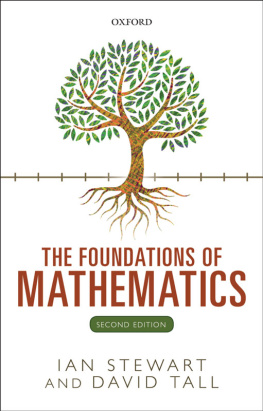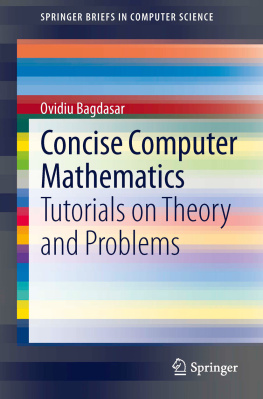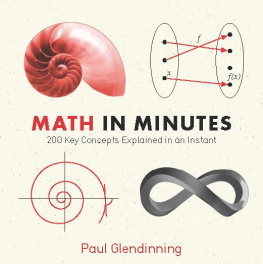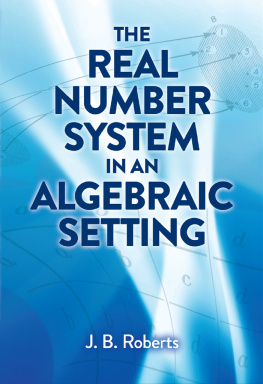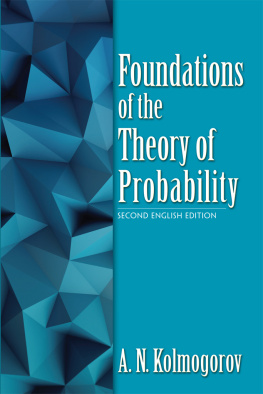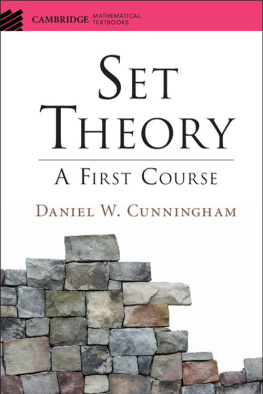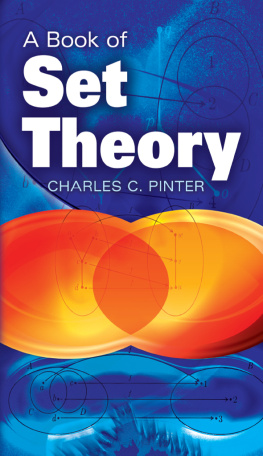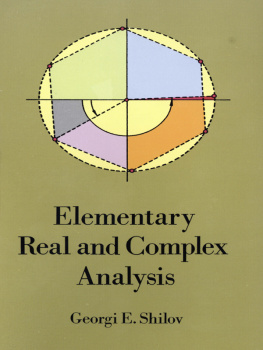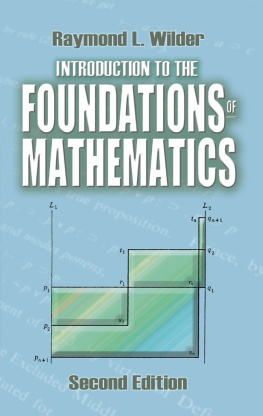
THE FOUNDATIONS OF MATHEMATICS

Great Clarendon Street, Oxford, OX2 6DP,
United Kingdom
Oxford University Press is a department of the University of Oxford. It furthers the Universitys objective of excellence in research, scholarship, and education by publishing worldwide. Oxford is a registered trade mark of Oxford University Press in the UK and in certain other countries
Joat Enterprises and David Tall 2015
The moral rights of the author have been asserted
First Edition published in 1977
Second Edition published in 2015
Impression: 1
All rights reserved. No part of this publication may be reproduced, stored in a retrieval system, or transmitted, in any form or by any means, without the prior permission in writing of Oxford University Press, or as expressly permitted by law, by licence or under terms agreed with the appropriate reprographics rights organization. Enquiries concerning reproduction outside the scope of the above should be sent to the Rights Department, Oxford University Press, at the address above
You must not circulate this work in any other form and you must impose this same condition on any acquirer
Published in the United States of America by Oxford University Press 198 Madison Avenue, New York, NY 10016, United States of America
British Library Cataloguing in Publication Data
Data available
Library of Congress Control Number: 2014946122
ISBN 9780191016486 (ebook)
ISBN 9780198706434 (pbk.)
Printed in Great Britain by
CPI Group (UK) Ltd, Croydon, CR0 4YY
Links to third party websites are provided by Oxford in good faith and for information only. Oxford disclaims any responsibility for the materials contained in any third party website referenced in this work.
TO
PROFESSOR RICHARD SKEMP
whose theories on the learning of mathematics have been a constant source of inspiration
Preface to the Second Edition
The world has moved on since the first edition of this book was written on typewriters in 1976. For a start, the default use of male pronouns is quite rightly frowned upon. Educationally, research has revealed new insights into how individuals learn to think mathematically as they build on their previous experience (see [ We have used these insights to add comments that encourage the reader to reflect on their own understanding, thereby making more sense of the subtleties of the formal definitions. We have also added an appendix on self-explanation (written by Lara Alcock, Mark Hodds, and Matthew Inglis of the Mathematics Education Centre, Loughborough University) which has been demonstrated to improve long-term performance in making sense of mathematical proof. We thank the authors for their permission to reproduce their advice in this text.
The second edition has much in common with the first, so that teachers familiar with the first edition will find that most of the original content and exercises remain. However, we have taken a significant step forward. The first edition introduced ideas of set theory, logic, and proof and used them to start with three simple axioms for the natural numbers to construct the real numbers as a complete ordered field. We generalised counting to consider infinite sets and introduced infinite cardinal numbers. But we did not generalise the ideas of measuring where units could be subdivided to give an ordered field.
In this edition we redress the balance by introducing a new that retains the chapter on infinite cardinal numbers while adding a new chapter on how the real numbers as a complete ordered field can be extended to a larger ordered field.
This is part of a broader vision of formal mathematics in which certain theorems called structure theorems prove that formal structures have natural interpretations that may be interpreted using visual imagination and symbolic manipulation. For instance, we already know that the formal concept of a complete ordered field may be represented visually as points on a number line or symbolically as infinite decimals to perform calculations.
Structure theorems offer a new vision of formal mathematics in which formal defined concepts may be represented in visual and symbolic ways that appeal to our human imagination. This will allow us to picture new ideas and operate with them symbolically to imagine new possibilities. We may then seek to provide formal proof of these possibilities to extend our theory to combine formal, visual, and symbolic modes of operation.
In introduces group theory, where the formal idea of a groupa set with an operation that satisfies a particular list of axiomsis developed to prove a structure theorem showing that elements of the group operate by permuting the elements of the underlying set. This structure theorem enables us to interpret the formal definition of a group in a natural way using algebraic symbolism and geometric visualisation.
Following uses the completeness axiom for the real numbers to prove a simple structure theorem for any ordered field extension K of the real numbers. This shows that K must contain elements k that satisfy k > r for all real numbers r, which we may call infinite elements, and these have inverses h = 1/k that satisfy 0 < h < r for all positive real numbers r, which may be called infinitesimals. (There are corresponding notions of negative infinite numbers k satisfying k < r for all negative real numbers r.) The structure theorem also proves that any finite element k in K (meaning a < k < b for real numbers a, b) must be of the form a + h where a is a real number and h is zero or an infinitesimal. This allows us to visualise the elements of the larger field K as points on a number line. The clue lies in using the magnification m : KK given by m(x) = (x - a)/h which maps a to 0 and a + h to 1, scaling up infinitesimal detail around a to be able to see it at a normal scale.
This possibility often comes as a surprise to mathematicians who have worked only within the real numbers where there are no infinitesimals. However, in the larger ordered field we can now see infinitesimal quantities in a larger ordered field as points on an extended number line by magnifying the picture.
This reveals two entirely different ways of generalising number concepts, one generalising counting, the other generalising the full arithmetic of the real numbers. It offers a new vision in which axiomatic systems may be defined to have consistent structures within their own context yet differing systems may be extended to give larger systems with different properties. Why should we be surprised? The system of whole numbers does not have multiplicative inverses, but the field of real numbers does have multiplicative inverses for all non-zero elements. Each extended system has properties that are relevant to its own particular context. This releases us from the limitations of our real-world experience to use our imagination to develop powerful new theories.
The first edition of the book took students from their familiar experience in school mathematics to the more precise mathematical thinking in pure mathematics at university. This second edition allows a further vision of the wider world of mathematical thinking in which formal definitions and proof lead to amazing new ways of defining, proving, visualising, and symbolising mathematics beyond our previous expectations.
Next page
